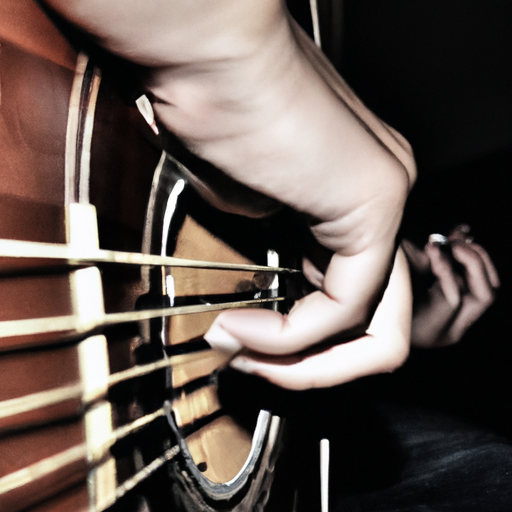
Learning to play the guitar is a fulfilling and rewarding journey. Whether you aspire to become a professional musician or simply want to strum along to your favorite songs, mastering the guitar playing basics is essential. In this article, we will explore the importance of learning these basics and the benefits it can bring.

When starting out on the guitar, it is crucial to build a strong foundation of basic skills. These fundamentals include understanding the anatomy of the guitar, proper posture, tuning, basic chords, strumming techniques, fingerpicking, reading guitar tabs, and practicing various exercises. By mastering these basics, beginners can lay the groundwork for more advanced techniques and musical exploration.

Mastering the guitar playing basics offers numerous benefits. Firstly, it allows beginners to play their favorite songs and participate in jam sessions with other musicians. Secondly, it provides a solid understanding of music theory and helps with improvisation and songwriting. Additionally, learning the basics builds confidence and motivation, making it easier to progress as a guitarist.
Before delving into playing techniques, it's important to familiarize yourself with the different parts of a guitar and how they contribute to its sound.
A guitar consists of various components, including the body, neck, headstock, fretboard, strings, bridge, and tuning pegs. Each part plays a significant role in shaping the guitar's sound and overall playability. Understanding these parts will help beginners appreciate the instrument and make informed decisions when choosing a guitar.
The body of the guitar resonates and amplifies the sound produced by the strings. The neck holds the frets and allows players to change pitch. The headstock houses the tuning pegs, which are used to adjust the tension of the strings and tune the guitar. The fretboard determines the length of the strings and the placement of the notes, while the bridge holds the strings in place and transmits their vibrations to the body.
Proper posture when holding the guitar is essential for comfort and optimal playing technique. There are a few different ways to hold the guitar, depending on the player's preference and the style of music being played.
When sitting, it is important to sit upright with a straight back and rest the guitar on the leg closest to the dominant hand. The guitar should be positioned so that your strumming or picking arm can move freely without any strain on the wrist or shoulder. Maintaining good posture will prevent discomfort and potential injuries in the long run.
There are two common ways to hold the guitar: classical position and casual position. In the classical position, the guitar is held on the left leg with a footstool to elevate the leg. This position is used primarily for classical and fingerstyle playing. In the casual position, the guitar is held on the right leg with no footstool. This position is commonly used for strumming and playing in a seated position.
Tuning the guitar is a crucial step before playing. A well-tuned guitar ensures that the pitches produced by each string are accurate, allowing for pleasant and harmonious music.
Tuning the guitar is important because even the slightest deviation from the correct pitch can have a significant impact on the overall sound. Playing an out-of-tune guitar can be frustrating and may hinder progress. It is recommended to tune the guitar every time before playing to develop a good ear for pitch and maintain consistent playing.
There are several methods to tune the guitar, including using a chromatic tuner, tuning by ear, or using a smartphone app. Chromatic tuners are precise and easy to use, while tuning by ear requires a good sense of pitch. Smartphone apps offer convenience and accuracy. Whichever method you choose, it is essential to familiarize yourself with the standard tuning of the guitar (E, A, D, G, B, E) and learn how to adjust the tension of each string accordingly.
Basic chords are the building blocks of many songs. Learning a few essential chords will allow beginners to play a wide range of songs and develop their chord vocabulary.
Some essential chords for beginners include the open chords: C, D, E, G, A, and F. These chords form the backbone of many popular songs and are relatively easy to learn.
To play each chord, place your fingers on the appropriate strings and frets as shown in chord diagrams. Strum the strings with your picking hand to produce the sound of the chord. Common chord progressions include the I-IV-V progression, the I-VI-IV-V progression, and the I-V-VI-IV progression. These progressions are widely used in various genres of music and provide a solid foundation for playing songs.
Strumming techniques add rhythm and texture to the guitar playing. Different strumming patterns can create different moods and enhance the overall musical experience.
Strumming patterns vary across different genres such as folk, rock, blues, and reggae. Each genre has its unique rhythmic feel and characteristic strumming patterns. Exploring different genres and their strumming patterns will help beginners develop their playing style and versatility.
To achieve a clean and consistent sound while strumming, it is important to maintain a relaxed grip on the pick and focus on the movement of your wrist and arm. Practice strumming with consistent downstrokes and upstrokes, paying attention to the muting of unwanted strings. Start slowly and gradually increase your speed as you become more comfortable with the technique.
Fingerpicking is a technique that involves plucking the strings with the fingers instead of using a pick. It adds a melodic and intricate quality to the guitar playing.
When fingerpicking, each finger is assigned to pluck a specific string. The thumb primarily handles the bass strings, while the index, middle, and ring fingers pluck the treble strings. Learning fingerpicking patterns and practicing coordination between the fingers is essential to master this technique.
Practicing fingerpicking exercises, such as playing arpeggios and fingerstyle arrangements of songs, can greatly improve fingerpicking skills. Start with simple patterns and gradually progress to more complex ones. Consistent practice and patience are key to developing dexterity and control.
Guitar tabs provide a simplified notation system for guitar players. They are easy to read and allow beginners to learn songs without having to read traditional musical notation.
Guitar tabs consist of horizontal lines representing the strings and numbers indicating the frets to press. Each number corresponds to a specific fret on a specific string. Tabs also incorporate other symbols to indicate techniques such as slides, bends, and hammer-ons.
To read guitar tabs, start by familiarizing yourself with the string names and numbers corresponding to each string. The numbers on the lines indicate the frets to press. Other symbols used in tabs include slides (/, \), bends (^), pull-offs (p), hammer-ons (h), and palm muting (PM). Understanding these symbols will help you accurately interpret and play the tablature.
Regular practice is essential for progressing as a guitarist. Incorporating specific exercises into your practice routine can help strengthen your fingers, improve coordination, and enhance overall playing ability.
Before diving into playing songs or practicing techniques, it is important to warm up your fingers and hands. Simple warm-up exercises such as finger stretching, hand rolls, and finger tapping can help prevent injuries and prepare your muscles for playing.
Exercises that focus on finger strength and dexterity are essential for building the necessary finger strength to navigate the fretboard. Some exercises include spider crawls, chromatic scales, and finger independence exercises. Regular practice of these exercises will improve coordination and enable you to play more complex pieces.
Mastering the guitar playing basics is crucial for beginners to build a solid foundation for their musical journey. It involves understanding the anatomy of the guitar, holding the guitar properly, tuning, learning basic chords, strumming and fingerpicking techniques, reading guitar tabs, and practicing various exercises.
Learning to play the guitar is a journey that requires consistent practice, patience, and dedication. It's important to embrace the learning process, enjoy the small victories, and keep challenging yourself to improve. With time and effort, you will develop your own unique style and become a proficient guitarist.
Remember, the guitar playing basics are just the beginning. Continue exploring new techniques, styles, and genres to expand your musical horizons. Enjoy the journey and keep playing!
For more information about guitar playing basics, visit https://chothuebannhac.net/cho-thue-ban-nhac/luom-lat-tin-do-day/.